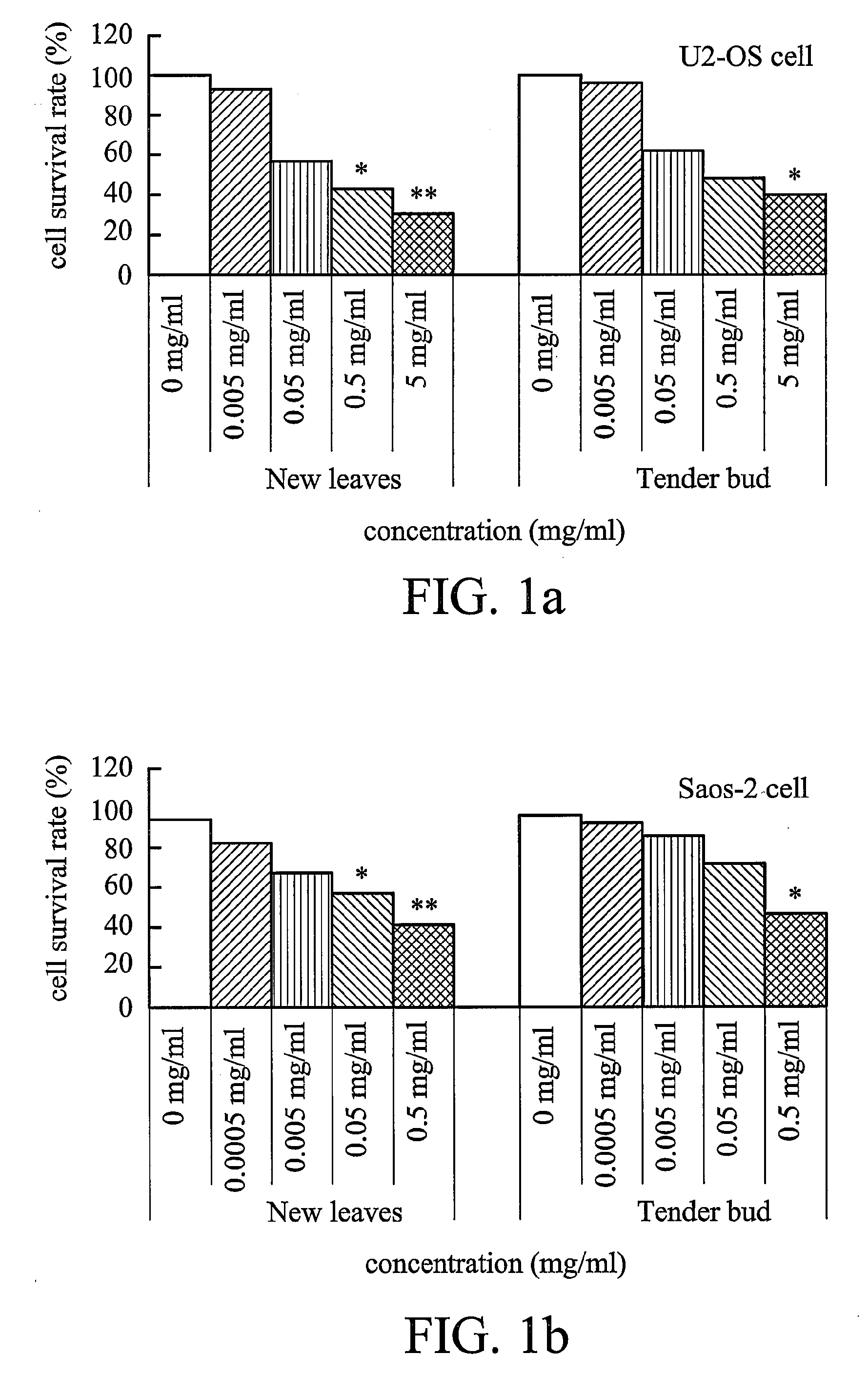Toona sinensis extract for suppressing proliferation and inducing apoptosis of osteosarcoma cells
a technology of toona sinensis and extract, which is applied in the field of extract of toona sinensis, can solve the problems of not teaching or suggesting a new use of toona sinensis or extracts for suppressing the growth of osteosarcoma, and achieves the effects of increasing the treatment time of tsl-1
- Summary
- Abstract
- Description
- Claims
- Application Information
AI Technical Summary
Benefits of technology
Problems solved by technology
Method used
Image
Examples
example
Example 1
Preparation of Extracts from Leaves of the Toona Sinensis
[0045]Tender leaves of the Toona sinensis were picked and washed briskly with water. A suitable amount of water was added to the leaves in a proportion of 4 liters of RO water to 1 kg of leaves. The mixture was heated to a boil and kept boiling. Then, the leaves were removed, and the remainder was heated slowly to a concentrate, which was filtered with a filter sieve (70-mesh). The filtered concentrate was lyophilized using a Virtis apparatus to obtain a crude extract, which was called “TSL-CE”.
[0046]Additionally, the filtered concentrate could be subjected to centrifugation prior to lyophilization. The filtered concentrate was centrifuged at 4° C. at 3000 rpm (Beckman Avanti™ J-30I) for 12 minutes to give a supernatant portion and a precipitate portion containing insoluble substances. The supernatant portion was subjected to lyophilization using a Virtis apparatus to obtain a lyophilized water extract, which was cal...
example 2
Effect of the Toona Sinensis Extract on Inhibiting Proliferation of Osteosarcoma Cell
[0048]The effect of the Toona sinensis extract on the inhibition of cell proliferation of osteosarcoma cells was analyzed by an MTT assay. FIGS. 1A and 1B shows the MTT assay results of U2-OS cell and Saos-2 cell, respectively. Referring to FIGS. 1A-1B, the TSL-1 extracted from new leaves could effectively suppress the proliferation of U2-OS cell and Saos-2 cell (IC50 was 59.6 μg / ml and 86.4 μg / ml for U2-OS cell and Saos-2 cell, respectively), and the TSL-1 extracted from tender buds could slightly suppress the proliferation of U2-OS cell and Saos-2 cell (IC50 was 64.7 μg / ml and 98.2 μg / ml for U2-OS cell and Saos-2 cell, respectively).
[0049]Additionally, TSL-1 was further treated by steam sterilization, and then the osteosarcoma cell (U2-OS cell and Saos-2 cell) was cultured on a medium containing the sterilized TSL-1 for 72 hours. In the control group, the TSL-1 was not treated with steam steriliza...
example 3
Effect of the Toona Sinensis Extract on the Proliferation of Normal Bone Cell
[0050]The human osteoblast cell was treated with TSL-1, TSL-2, and TSL-1-5-7 extracted from new leaves, respectively, to analyze the effect of the Toona sinensis extract on the growth of normal bone cells. The treatment time was 72 hours. Referring to FIG. 3, TSL-1 and TSL-2 did not suppress the proliferation of the human osteoblast cells. Accordingly, FIG. 3 indicates that TSL-1 not only suppressed the proliferation of osteosarcoma cells, but also did not cause biological damage to normal cell.
PUM
| Property | Measurement | Unit |
|---|---|---|
| treatment time | aaaaa | aaaaa |
| boiling | aaaaa | aaaaa |
| pH | aaaaa | aaaaa |
Abstract
Description
Claims
Application Information
 Login to View More
Login to View More - R&D
- Intellectual Property
- Life Sciences
- Materials
- Tech Scout
- Unparalleled Data Quality
- Higher Quality Content
- 60% Fewer Hallucinations
Browse by: Latest US Patents, China's latest patents, Technical Efficacy Thesaurus, Application Domain, Technology Topic, Popular Technical Reports.
© 2025 PatSnap. All rights reserved.Legal|Privacy policy|Modern Slavery Act Transparency Statement|Sitemap|About US| Contact US: help@patsnap.com



